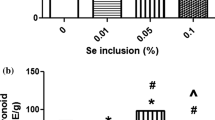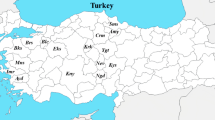Abstract
This study aims to conduct a detailed investigation on four cultivars grown in northwest China, concentrating on the analysis of the bioactive contents, nutrients, heavy metal concentrations, and pesticide residue contents. Those Chinese jujubes consist of 51.99–71.75% edible part, 82.35–89.63% carbohydrates, 4.43–6.01% protein, 0.48–0.63% lipid, 2.80–4.80% polysaccharide, 45.64–88.97 mg/100 g ascorbic acid, 132.16–196.58 mg/100 g phenolics and 101.17–132.04 mg/100 g flavonoids in dry matter. In those four Chinese jujube cultivars, sulfur amino acids are the first limiting amino acids for adults, and aromatic amino acids are for children. The amount of heavy metal and pesticide residue concentrations in those jujubes was way below the limit. All four cultivars were found to have different nutritional values except for the carbohydrates; they had higher rates of carbohydrates and polysaccharide than those previously reported ones from Eastern China; and they are a better source for carbohydrates, vitamin C and functional amino acids.


Similar content being viewed by others
Abbreviations
- HPZ:
-
Ziziphus jujube cv. Hupingzao
- HZ:
-
Ziziphus jujube cv. Huizao
- XZ:
-
Ziziphus jujube cv. Xiaozao
- JZ:
-
Ziziphus jujube cv. Junzao
- GAE:
-
Garlic acid equivalent
- TAA:
-
Total amino acids
- EAA:
-
Essential amino acids
- FAA:
-
Functional amino acids
- CNS:
-
Chinese national standard
- HCB:
-
Hexachlorobenzene
- HCHs:
-
Hexachlorocyclohexane isomers
- o,p′-DDT:
-
1,1,1-(trichloro)-2-(p-chlorophenyl)-2-(o-chlorophenyl)ethane
- p,p′-DDE:
-
2,2-bis(4-chlorophenyl)-1,1-dichloroethylene
- p,p′-DDD:
-
2,2-bis(4-chlorophenyl)-1,1-dichloroethane
- p,p′-DDT:
-
1,1-bis(4-chlorophenyl)-2,2,2-trichloroethane
References
Gao, Q.-H., C.-S. Wu, and M. Wang. The Jujube (Ziziphus Jujuba Mill.) Fruit: A Review of Current Knowledge of Fruit Composition and Health Benefits. Journal of Agricultural and Food Chemistry. 61: 3351–3363 (2013)
Ministry of Health, P. Further standardize the management of functional food raw materials N.H.a.F.P.C.o.t.P.s.R.o. China, Editor. 2002, National Health and Family Planning Commition of the People’s Republic of China: Beijing.
Goetz, P. Demonstration of the psychotropic effect of mother tincture of Ziziphus jujuba Mill. Phytotherapie (Paris). 7: 31–36 (2009)
Jiang, J.-G., X.-J. Huang, J. Chen, and Q.-S. Lin. Comparison of the sedative and hypnotic effects of flavonoids, saponins, and polysaccharides extracted from Semen Ziziphus jujube. Natural Product Research. 21: 310–320 (2007)
Mahajan, R.T. and M.Z. Chopda. Phyto-pharmacology of Ziziphus jujuba Mill—a plant review. Pharmacognosy Reviews. 3: 320–329 (2009)
Naftali, T., H. Feingelernt, Y. Lesin, A. Rauchwarger, and F.M. Konikoff. Ziziphus jujuba Extract for the Treatment of Chronic Idiopathic Constipation: A Controlled Clinical Trial. Digestion. 78: 224–228 (2008)
Ebrahimi, S., S. Ashkani-Esfahani, and A. Poormahmudi. Investigating the Efficacy of Ziziphus Jujuba on Neonatal Jaundice. Iranian Journal of Pediatrics. 21: 320–324 (2011)
He, R.P., J. Li, F. Zhao, W.N. Kong, and R.S. Niu. Study on fruit quality of jujube varieties during maturity. 553–556. In: Acta Horticulturae. M.J. Liu, Editor (2009)
Liu, D.Z., C.T. Wang, T.J. Yu, L.Q. Hou, and D.C. Zhao. Two New Wild Jujube Cultivars—’Dasuanzao’ and ‘Cuisuanzao’. 840. 255–258. In: I International Jujube Symposium. M.J. Liu, Editor (2009)
Wang, Y., F. Tang, J. Xia, T. Yu, J. Wang, R. Azhati, and X.D. Zheng. A combination of marine yeast and food additive enhances preventive effects on postharvest decay of jujubes (Ziziphus jujuba). Food Chemistry. 125: 835–840 (2011)
Wang, H., F. Chen, H. Yang, Y. Chen, L. Zhang, and H. An. Effects of ripening stage and cultivar on physicochemical properties and pectin nanostructures of jujubes. Carbohydrate Polymers. 89: 1180–1188 (2012)
Zhao, Y., P. Wu, Y. Wang, and H. Feng. Different approaches for selenium biofortification of pear-jujube (Ziziphus jujuba M. cv. Lizao) and associated effects on fruit quality. Journal of Food Agriculture & Environment. 11: 529–534 (2013)
Chen, W.-t., D.-y. Yuan, R.-q. Zhang, Z.-g. Han, C.-y. Huang, and L. Duan. Factor analysis and comprehensive assessment on quality characters of fresh jujube cultivars. Journal of Hunan Agricultural University. 40: 32–6 (2014)
Liu, M.J. Genetic diversity of Chinese jujube (Zidphus jujuba mill.). 351-355. In: Plant Genetic Resources: The Fabric of Horticulture’s Future. P.L. Forsline, et al., Editors (2003)
Liu, M.J. and J. Zhao. RAPD analysis on the cultivars, strains and related species of Chinese jujube. 477–484. In: Genetics and Breeding of Tree Fruits and Nuts. J. Janick, Editor (2003)
Wu, G.L. and C.J. Ning. Effects of applying selenium to Chinese jujube on the fruit quality and mineral elements content. 199–207. In: Acta Horticulturae. M. Liu and Z. Zhao, Editors (2013)
Mecozzi, M. Estimation of total carbohydrate amount in environmental samples by the phenol-sulphuric acid method assisted by multivariate calibration. Chemometrics and Intelligent Laboratory Systems. 79: 84–90 (2005)
Deetae, P., P. Parichanon, P. Trakunleewatthana, C. Chanseetis, and S. Lertsiri. Antioxidant and anti-glycation properties of Thai herbal teas in comparison with conventional teas. Food Chemistry. 133: 953–959 (2012)
Ardestani, A. and R. Yazdanparast. Inhibitory effects of ethyl acetate extract of Teucrium polium on in vitro protein glycoxidation. Food and Chemical Toxicology. 45: 2402–2411 (2007)
Li, J.-W., L.-P. Fan, S.-D. Ding, and X.-L. Ding. Nutritional composition of five cultivars of chinese jujube. Food Chemistry. 103: 454–460 (2007)
Danthu, P., P. Soloviev, A. Totte, E. Tine, N. Ayessou, A. Gaye, T.D. Niang, M. Seck, and M. Fall. Jujube trees in Senegal: a comparison between the organoleptic and physico-chemical characteristics of the wild fruits and the introduced Gola variety. Fruits (Paris). 57: 173–182 (2002)
Tang, Z.X., L.E. Shi, and S.M. Aleid. Date fruit: chemical composition, nutritional and medicinal values, products. Journal of the Science of Food and Agriculture. 93: 2351–2361 (2013)
Gao, Q.H., C.S. Wu, J.G. Yu, M. Wang, Y.J. Ma, and C.L. Li. Textural Characteristic, Antioxidant Activity, Sugar, Organic Acid, and Phenolic Profiles of 10 Promising Jujube (Ziziphus jujuba Mill.) Selections. Journal of Food Science. 77: C1218-C1225 (2012)
Yue, Y., S. Wu, Z. Li, J. Li, X. Li, J. Xiang, and H. Ding. Wild jujube polysaccharides protect against experimental inflammatory bowel disease by enabling enhanced intestinal barrier function. Food Funct. 6: 2568–77 (2015)
Liu, G., X. Liu, Y. Zhang, F. Zhang, T. Wei, M. Yang, K. Wang, Y. Wang, N. Liu, H. Cheng, and Z. Zhao. Hepatoprotective effects of polysaccharides extracted from Ziziphus jujuba cv. Huanghetanzao. International Journal of Biological Macromolecules. 76: 169–175 (2015)
Gao, Q. and M. Wang. Promising polysaccharide fractions from jujube (Ziziphus jujuba Mill.) fruit. Journal of Chemical and Pharmaceutical Research. 7: 178–183 (2015)
Gao, Q., C. Bai, and M. Wang. Polysaccharides in jujube (Ziziphus jujuba Mill.) fruit: extraction, antioxidant properties and inhibitory potential against a-amylase in vitro. Journal of Chemical and Pharmaceutical Research. 7: 943–949 (2015)
Chi, A., C. Kang, Y. Zhang, L. Tang, H. Guo, H. Li, and K. Zhang. Immunomodulating and antioxidant effects of polysaccharide conjugates from the fruits of Ziziphus jujube on Chronic Fatigue Syndrome rats. Carbohydrate Polymers. 122: 189–196 (2015)
Kou, X., Q. Chen, X. Li, M. Li, C. Kan, B. Chen, Y. Zhang, and Z. Xue. Quantitative assessment of bioactive compounds and the antioxidant activity of 15 jujube cultivars. Food Chemistry. 173: 1037–1044 (2015)
Wu, C.-S., Q.-H. Gao, X.-D. Guo, J.-G. Yu, and M. Wang. Effect of ripening stage on physicochemical properties and antioxidant profiles of a promising table fruit ‘pear-jujube’ (Ziziphus jujuba Mill.). Scientia Horticulturae. 148: 177–184 (2012)
Society, C.N. Chinese DRIs Handbook. China Standar Press, Beijing. 50. (2013)
Franke, A.A., L.J. Custer, C. Arakaki, and S.P. Murphy. Vitamin C and flavonoid levels of fruits and vegetables consumed in Hawaii. Journal of Food Composition and Analysis. 17: 1–35 (2004)
Choi, S.-H., J.-B. Ahn, N. Kozukue, C.E. Levin, and M. Friedman. Distribution of Free Amino Acids, Flavonoids, Total Phenolics, and Antioxidative Activities of Jujube (Ziziphus jujuba) Fruits and Seeds Harvested from Plants Grown in Korea. Journal of Agricultural and Food Chemistry. 59: 6594–6604 (2011)
Wu, G.Y. Functional amino acids in nutrition and health. Amino Acids. 45: 407–411 (2013)
Guo, J., T. Yue, X. Li, and Y. Yuan. Heavy metal levels in kiwifruit orchard soils and trees and its potential health risk assessment in Shaanxi, China. Environ Sci Pollut Res Int. (2016)
Acknowledgements
We send our greatest appreciations to the Forestry Bureau of Minqin County (Gansu, China; Grant No.201505510610433) for their generous financial support and kind assistance in sampling. We also appreciate the valuable academic and technical support we received from Prof. Wangfu Bi, Xuan wang, Liyue Yue, Mamun-or-Rashid and other lab-mates. We give our special thanks to Pengshan Li and Hongzhang Li for their assistance in sampling and data collection, and to Dr. Pushparajah Thavarajah (from University of Saskatchewan, Canada) for his assistance in manuscript editing. We send our final appreciation to our beloved friend Mr. Edward Oyama (from the US) for final proofreading.
Author information
Authors and Affiliations
Corresponding authors
Ethics declarations
Conflict of interest
There is not any conflict of interest with all authors.
Rights and permissions
About this article
Cite this article
Rahman, E., Momin, A., Zhao, L. et al. Bioactive, nutritional composition, heavy metal and pesticide residue of four Chinese jujube cultivars. Food Sci Biotechnol 27, 323–331 (2018). https://doi.org/10.1007/s10068-017-0256-2
Received:
Revised:
Accepted:
Published:
Issue Date:
DOI: https://doi.org/10.1007/s10068-017-0256-2




